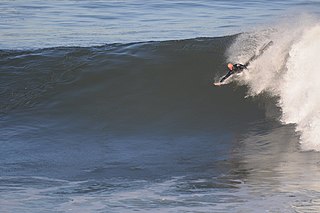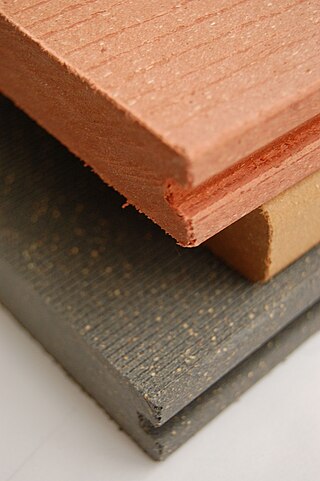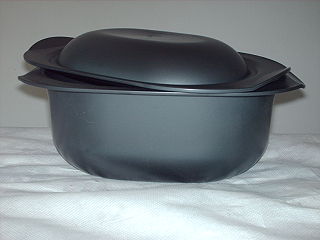
Surfing is a surface water sport in which an individual, a surfer, uses a board to ride on the forward section, or face, of a moving wave of water, which usually carries the surfer towards the shore. Waves suitable for surfing are primarily found on ocean shores, but can also be found in standing waves in the open ocean, in lakes, in rivers in the form of a tidal bore, or in wave pools.

Polystyrene (PS) is a synthetic polymer made from monomers of the aromatic hydrocarbon styrene. Polystyrene can be solid or foamed. General-purpose polystyrene is clear, hard, and brittle. It is an inexpensive resin per unit weight. It is a poor barrier to air and water vapor and has a relatively low melting point. Polystyrene is one of the most widely used plastics, with the scale of its production being several million tonnes per year. Polystyrene is naturally transparent, but can be colored with colorants. Uses include protective packaging, containers, lids, bottles, trays, tumblers, disposable cutlery, in the making of models, and as an alternative material for phonograph records.
Fiberglass or fibreglass is a common type of fiber-reinforced plastic using glass fiber. The fibers may be randomly arranged, flattened into a sheet called a chopped strand mat, or woven into glass cloth. The plastic matrix may be a thermoset polymer matrix—most often based on thermosetting polymers such as epoxy, polyester resin, or vinyl ester resin—or a thermoplastic.

Bodyboarding is a water sport in which the surfer rides a bodyboard on the crest, face, and curl of a wave which is carrying the surfer towards the shore. Bodyboarding is also referred to as Boogieboarding due to the invention of the "Boogie Board" by Tom Morey in 1971. The average bodyboard consists of a short, rectangular piece of hydrodynamic foam. Bodyboarders typically use swim fins for additional propulsion and control while riding a breaking wave.

A surfboard is a narrow plank used in surfing. Surfboards are relatively light, but are strong enough to support an individual standing on them while riding an ocean wave. They were invented in ancient Hawaii, where they were known as papa he'e nalu in the Hawaiian language, and were usually made of wood from local trees, such as koa. They were often over 460 cm (15 ft) in length and extremely heavy. Major advances over the years include the addition of one or more fins (skegs) on the bottom rear of the board to improve directional stability, and numerous improvements in materials and shape.

Bodysurfing is the art and sport of riding a wave without the assistance of any buoyant device such as a surfboard or bodyboard. Bodysurfers often equip themselves with a pair of swimfins that aid propulsion and help the bodysurfer catch, ride, and kick out of waves. Some bodysurfers also use a wooden or foam handplane, which helps to get one's chest out of the water to reduce drag, this is known as handplaning and is an offshoot of bodysurfing.

Wood–plastic composites (WPCs) are composite materials made of wood fiber/wood flour and thermoplastic(s) such as polythene (PE), polypropylene (PP), polyvinyl chloride (PVC), or polylactic acid (PLA).
Underlay may refer to flooring or roofing materials, bed padding, or a musical notation.

A coffee cup is a container, a cup, for serving coffee and coffee-based drinks. There are three major types: conventional cups used with saucers, mugs used without saucers, and disposable cups. Cups and mugs generally have a handle. Disposable paper cups used for take-out sometimes have fold-out handles, but are more often used with an insulating coffee cup sleeve.
Clark Foam was a Californian company that manufactured surfboard blanks — foam slabs, reinforced with one or more wooden strips or "stringers" — cast in the rough shape of a surfboard and used by surfboard shapers to create finished surfboards. Founded in 1961 by Gordon "Grubby" Clark, Clark Foam established a near-monopoly on the American market, and a strong presence in the international market, which it held until the company's unexpected closure in 2005.

Plastic lumber is a plastic form of lumber made of virgin or recycled plastic. It is mostly made of plastic and binders such as fiberglass or rebar; not to be confused with wood-plastic composite lumber. Widely employed in outdoor decking, it is also used for molding and trim and garden furniture such as park benches. Resistant to cracking and splitting when appropriately installed, plastic lumber can be molded with or without simulated wood grain details. Even with a wood grain design, plastic lumber is still easy to distinguish visually from natural timber: the grains are the same uniform color as the rest of the material.

A surfboard shaper is someone who designs and builds surfboards. The process of surfboard shaping has evolved over the years, and the shaper often tailors his or her work to meet the requirements of a client or a certain wave. Surfboard shapers can be independent or work in collaboration with mass-production companies.

Hobart "Hobie" Alter was an American surf and sailing entrepreneur and pioneer, creator of the Hobie Cat catamarans, and founder of the Hobie company.

Disposable food packaging comprises disposable products often found in fast-food restaurants, take-out restaurants and catering establishments. Typical products are foam food containers, plates, bowls, cups, utensils, doilies and tray papers. These products can be made from a number of materials including plastics, paper, bioresins, wood and bamboo.

Plastics are a wide range of synthetic or semi-synthetic materials that use polymers as a main ingredient. Their plasticity makes it possible for plastics to be moulded, extruded or pressed into solid objects of various shapes. This adaptability, plus a wide range of other properties, such as being lightweight, durable, flexible, and inexpensive to produce, has led to its widespread use. Plastics typically are made through human industrial systems. Most modern plastics are derived from fossil fuel-based chemicals like natural gas or petroleum; however, recent industrial methods use variants made from renewable materials, such as corn or cotton derivatives.

The Reincarnation of a Surfboard is a body of sculpture work created by Ithaka Darin Pappas. The project, which began in 1989 consist of approximately 300 wall-mounted sculptures that have been made using recycled surfboards as raw building material. The series to date has been exhibited on four continents. The most recent solo exhibitions of these works were mesa hosted by WOA - Way Of Arts in Cascais, Portugal in December 2012, by Hurley International in Costa Mesa, California in October 2013 and F+ Gallery in Santa Ana in February 2015.
UFP Technologies, Inc., founded in 1963 and based in Newburyport, Massachusetts, is a designer and custom manufacturer of medical devices, sterile packaging, and other products.

Plastic containers are containers made exclusively or partially of plastic. Plastic containers are ubiquitous either as single-use or reuseable/durable plastic cups, plastic bottles, plastic bags, foam food containers, Tupperware, plastic tubes, clamshells, cosmetic containers, up to intermediate bulk containers and various types of containers made of corrugated plastic. The entire packaging industry heavily depends on plastic containers or containers with some plastic content, besides paperboard and other materials. Food storage nowadays relies mainly on plastic food storage containers.

A yoga brick or yoga block is a smooth block of wood or of firm but comfortable material, such as hard foam rubber or cork, used as a prop in yoga as exercise.















